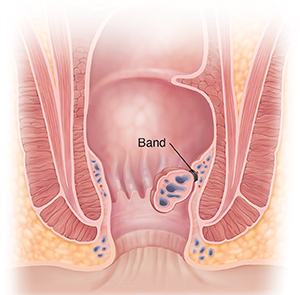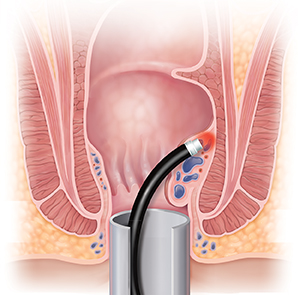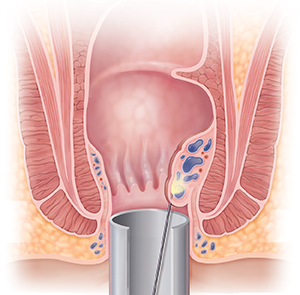Treating Hemorrhoids: Removal
If your hemorrhoid symptoms persist, your healthcare provider may recommend removing the hemorrhoid. This can be done in your healthcare provider's office or at a surgical center. In most cases, no special preparation is needed. Keep in mind that your treatment may differ depending on your symptoms and the location of the hemorrhoid.
Internal hemorrhoids
You’ll be asked to lie or kneel on a table. Your healthcare provider then inserts an anoscope to view the anal canal. To treat the hemorrhoid, your healthcare provider will use one of the methods listed below. Because internal hemorrhoids don't have nerves that sense pain, you won’t have too much discomfort. You can often return to your normal routine the same day. If you have many hemorrhoids, you may need repeated treatments.
Banding
The banding method is done by placing tight elastic bands around the base of the hemorrhoid. This cuts off blood supply to the hemorrhoid, causing it to fall off. This usually takes about a week. The area then heals within a few days.

Infrared coagulation
This procedure is done using a small probe that exposes the hemorrhoid to short bursts of infrared light. This seals off the blood vessel, causing it to shrink. Slight bleeding may happen for a few days. The area usually heals within a week or two.

Sclerotherapy
Sclerotherapy is done by injecting a chemical into the tissue around the hemorrhoid. The chemical causes the hemorrhoid to shrink within a few days. Bleeding usually stops in about 24 hours. This treatment is no longer done very often.

Thrombosed external hemorrhoids
Thrombosed external hemorrhoids are often very painful. That’s because the swollen hemorrhoid stretches the sensitive skin around it. To relieve the pain, your healthcare provider may remove the blood clot. This takes just a few minutes. You may need to rest for a few days before returning to work.
-
Numbing the hemorrhoid. You’ll be asked to lie or kneel on a table. The hemorrhoid is then injected with a local anesthetic. This may cause some discomfort for a moment. But, within a short time, your healthcare provider will be able to remove the hemorrhoid without causing pain.
-
Removing the hemorrhoid. A small incision is made to remove the blood clot. The hemorrhoid may also be removed. The skin is then either closed with stitches or left open to heal on its own. The area around the incision will likely be sore for a few days. But your pain should improve soon after the procedure.
If the clot has been present for more than a few days, it may be hard to remove it with an incision. In this case, it will get better on its on with time and your provider will monitor you.
Risks and possible complications
The risks and complications include:
-
Infection
-
Bleeding
-
Trouble urinating (Doesn't happen with thrombosed external hemorrhoids)
-
Narrowing of the anal canal (very rare, doesn't happen with thrombosed external hemorrhoids)
When to call your healthcare provider
After your procedure, call your healthcare provider if you have:
Online Medical Reviewer:
Jen Lehrer MD
Online Medical Reviewer:
L Renee Watson MSN RN
Online Medical Reviewer:
Rita Sather RN
Date Last Reviewed:
3/1/2022
© 2000-2024 The StayWell Company, LLC. All rights reserved. This information is not intended as a substitute for professional medical care. Always follow your healthcare professional's instructions.